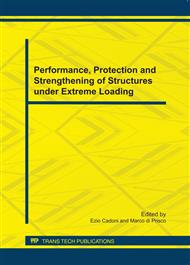[1]
Hughes, G., and Beeby, A. W.: Investigation of the effect of impact loading on concrete beams, The Structural Engineer, 60B (3), pp.45-52, 1982.
Google Scholar
[2]
Bresler, B. and MacGregor, J. G.: Review of Concrete Beams Failing in Shear, Journal of Structural Division, ASCE, Vol.93, No. ST1, pp.343-372, 1967.
DOI: 10.1061/jsdeag.0001586
Google Scholar
[3]
Japan Society of Civil Engineers (JSCE) (2002). " Standard Specifications for Concrete Structures 2002", Structual Performance Verification (in Japanese) Table 1 Test case detail Designation
Shear span ratio
Shear reinforcement ratio pw[%]
Loading rate [m/s]
Designation
Shear span ratio
Shear reinforcement ratio pw[%]
Loading rate [m/s]
RC1S0S
1.90
0
4.0×10-4
RC3S0S
3.33
0
4.0×10-4
RC1S0L
4.0×10-2
RC3S0L
4.0×10-2
RC1S0M
4.0×10-1
RC3S0M
4.0×10-1
RC1S0H
2.0×100
RC3S0H
2.0×100
RC1S42S
0.42
4.0×10-4
RC3S42S
0.12
4.0×10-4
RC1S42L
4.0×10-2
RC3S42L
4.0×10-2
RC1S42M
4.0×10-1
RC3S42M
4.0×10-1
RC1S42H
2.0×100
RC3S42H
2.0×100
RC1S84S
0.84
4.0×10-4
RC3S84S
0.60
4.0×10-4
RC1S84L
4.0×10-2
RC3S84L
4.0×10-2
RC1S84M
4.0×10-1
RC3S84M
4.0×10-1
RC1S84H
2.0×100
RC3S84H
2.0×100 RC1 S Shear span - to - depth ratio RC 1 = 1 . 90 % RC 3 = 3 . 33 % Shear reinforcement ratio S 0 = 0 % S 12 = 0 . 12 % S 42 = 0 . 42 % S 60 = 0 . 60 % S 84 = 0 . 84 % Loading rate S = 4 . 0 × 10 - 4 m / s L = 4 . 0 × 10 - 2 m / s M = 4 . 0 × 10 - 1 m / s H = 2 . 0 × 10 0 m / s S42 Fig.1 Test case designation (a) RC1 (b) RC3 Fig.2 RC beam specimen detail Table 2 Flexure and shear resistances of RC beams Specimen
Flexure reinforcement ratio[%]
Shear reinforcement ratio[%]
Design flexural resistance[kN]
Design shear resistance[kN]
Safety margin of shear strength
Expected failure mode
RC3S0
2.46
0
121.8
66.8
0.55
Shear
RC3S12
0.12
86.5
0.71
Shear
RC3S60
0.60
165.1
1.36
Flexure
RC1S0
0
213.1
121.0
0.57
Shear
RC1S42
0.42
189.8
0.89
Shear
RC1S84
0.84
230.0
1.08
Flexure Fig.3 Servo-controlled rapid loading machine Fig.4 Arrangement of strain gages for reinforcing bars Fig.5 Arrangement of concrete strain gages and accelerometers Fig.6 Typical failure modes of RC beams (c) RC1S84 (b) RC1S42 (a) RC1S0 (f) RC3S60 (e) RC3S12 (d) RC3S0 Fig.7 Load–midspan deflection relationships of RC specimens (b) RC3 (a) RC1 Fig.8 Relationship between loading rate and dynamic increase ratio of max. resistance
Google Scholar


